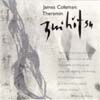 James is curator of the lowercase sound email discussionforum, so it's not surprising that 'Zuihitsu' is a fairly quietcollection that works up to occasional skittering resolutions relyingon fast paced interaction but mostly squeaks and gurgles in a playfulbut subdued manner. One track is titled "Zwittering Maschines" andzwittering seems a good word to describe the sound of 'Zuihitsu.' It'sdifficult for me to hear this CD without being reminded of the voicesof classic cult BBC kids TV show The Clangers, the moon dwellingwoollen puppets with squeaky voices. Perhaps that's appropriateconsidering the influence of bird sounds on James Coleman's improvisingtechnique, and the image the theremin has as a kitsch sci-fi soundtracktool. "This Castle Keeps Me" opens with a low drone that eventuallyswoops off over sparse and slow atmospheric drum beats. "Burial of theCombs" is a more dissonant follow up with slow scraping cello from VicRawlings. On "Katydid" the theremin conspires with Bob Rainey's sax tosound like a dog whining in curiosity at odd percussive occurrences.Greg Kelley's trumpet brings a strangled gurgle to "Muddy Kemaris" forbird like twitters to flit around, before launching drawn out keeningsover drum rolls. "Lady of the Combs" adds some stuttering jerky vocalsfrom Liz Tonne which instantly lifts the music into a more tense mode,as she sounds quite distraught. Her vocals on a handful of later tracksare much more subdued and merge organically.
James is curator of the lowercase sound email discussionforum, so it's not surprising that 'Zuihitsu' is a fairly quietcollection that works up to occasional skittering resolutions relyingon fast paced interaction but mostly squeaks and gurgles in a playfulbut subdued manner. One track is titled "Zwittering Maschines" andzwittering seems a good word to describe the sound of 'Zuihitsu.' It'sdifficult for me to hear this CD without being reminded of the voicesof classic cult BBC kids TV show The Clangers, the moon dwellingwoollen puppets with squeaky voices. Perhaps that's appropriateconsidering the influence of bird sounds on James Coleman's improvisingtechnique, and the image the theremin has as a kitsch sci-fi soundtracktool. "This Castle Keeps Me" opens with a low drone that eventuallyswoops off over sparse and slow atmospheric drum beats. "Burial of theCombs" is a more dissonant follow up with slow scraping cello from VicRawlings. On "Katydid" the theremin conspires with Bob Rainey's sax tosound like a dog whining in curiosity at odd percussive occurrences.Greg Kelley's trumpet brings a strangled gurgle to "Muddy Kemaris" forbird like twitters to flit around, before launching drawn out keeningsover drum rolls. "Lady of the Combs" adds some stuttering jerky vocalsfrom Liz Tonne which instantly lifts the music into a more tense mode,as she sounds quite distraught. Her vocals on a handful of later tracksare much more subdued and merge organically.Although the album is made up of fifteen tracks with variouscombinations of improvisers, with only the theremin constantthroughout, the album merges seamlessly into a whole which could easilyhave been one long session. The final track "Released to the Stars"brings a low key resolution with Rawlings droning cello underpinningTonne's choking ululations which seem to suggest death and rebirth asthe sounds dissolve to silence.
The sleeve is a an imaginitively elegant affair which allows thelistener to choose one of three covers featuring different abstractoriental style art under tracing paper and quotes from William Blake,Kimo no Chomei or Elizabeth Millard. The quotes are spirituallysuggestive and compliment the intent of the music neatly. -